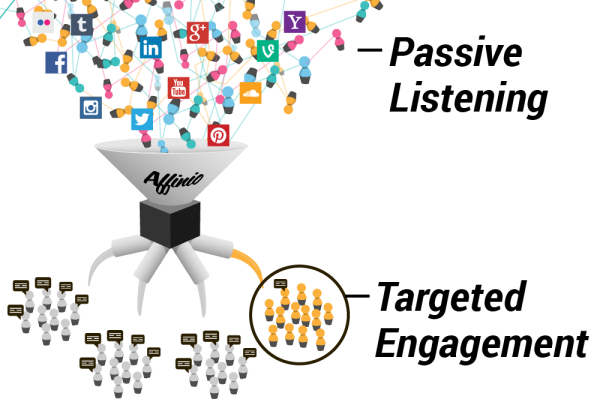Brand strategy on social media has evolved based on listening and engagement. Brands have been taught to use social in a very prescriptive way:
Step 1: Listen to who is mentioning your brand on social
Step 2: Engage with these people
Step 3: Create and publish content
Many brands believe that, if done correctly, “magic” happens and these ‘engagers’ become customers and brand advocates. However, there has been increasing questions about the ROI of social. Brands continue investing millions of dollars in social strategies and some are questioning if they are generating positive returns. They engage with thousands to millions of people every year, but how many of them are existing customers? Or will become customers? Or even fit the profile of an ideal customer?
We believe that the issues of many brand’s social strategies are tied to the underlying assumptions that brands have been sold on for years, namely:
-
People who engage with your brand = your ideal customers
-
Engagers are the only “valuable” members of social networks
These assumptions are simply wrong.
First, people who engage with a brand are often not customers, not qualified to become customers, and don’t even fit the persona of a customer. Brands have invested in the development of building targeted personas, but listening / engagement strategies provide no way to map these personas to social profiles. So brands continue to spend money engaging with these people because they have no way of establishing if these random people fit the profile of their customers or not.
Second, there is a lack of visibility into the network connectivity between people on social, the communities they belong to, and how they are influencing one another. The greatest value behind social networks, the network itself, has been dominantly ignored in social technologies overshadowed by engagement and vanity metrics.
This is where social technologies have failed brands, and where we see the opportunity for the foundation of evolved brand strategy on social.
We believe:
-
Social strategy should be based on active targeting, not passive listening Tweet this
-
The greatest value of social networks is the network itself
-
Ideal customers are ON social but may not BE social (80 – 90% of people on social “say” nothing, let alone mention your brand!)
How can a brand leverage Affinio’s affinity technology to transform its social strategy and improve ROI?
-
Audit your Social Audience: who is your brand currently attracting? What communities do they belong to? Who do they share common affinities / interests with? What are their social personas? Do they fit your ideal customer? We’ve written about how to create these social personas here
-
Stop Listening and Start Targeting: find the high-affinity communities (we call them “tribes”) on social that match your ideal customer, define the total addressable market (we can help you do this), and go after them with unified paid-owned-earned campaigns (we’ll show you how in our next post).
-
Tie KPIs to ROI: Drop the vanity metrics! Who cares if you have 100,000 more followers if they will never be customers? Develop KPIs that assess your social strategy against ONLY your target communities. How many of your target audience did you get to the top of your funnel and ultimately, how many of them converted? We’re building businesses – this is the ultimate ROI metric.
Welcome to Social 2.0. Ready to transform your brand’s social strategy?
This post originally appeared on the Affinio blog
